To see what pure joy looks like, watch how your pet embraces life! I love watching my anadoodle, Layla. She embraces life to the fullest. It doesn’t matter if her routine gets rearranged, or if it’s raining outside, or if she is suddenly awakened … she rolls with whatever life hands her. Her joy is contagious and fills our hearts and our home with pure joy. If you have a pet, then you know a pet is more than an animal; it’s a member of the family.
But let’s face it: they can be tough on a house. And sometimes their only saving grace is their adorable charm, as you’re cleaning up or repairing the damage caused by their exuberance for life. But there’s good news! You don’t have to choose between a stylish home and an industrial pet-proof home.
Here are several ways to create a stylish (yet durable) home with a pet-in-residence.
1. Pet Etiquette = a Happy Home
The best way to start designing your home is to establish some house rules and teach them to your four-legged companion. They want to know what their role is in the family mix. A stylish home commands respect, and just like teaching respect to our children, we need to teach respect to our pets. Our pets’ world revolves around pleasing us. And again, they’re like children in that they love routine, structure, and praise. All pets need manners and socialization skills. Once the house rules and manners you expect from your pet are decided, begin the teaching process and be consistent with your expectations. This will require time, effort, and patience on your part, even an obedience class or two, but it will be so worth it in the long run. It doesn’t matter the size of your pet; manners are the foundation to a beautiful home filled with harmony, appreciation, and joy. Read this article for inspiration: “Living with pets: the 10 rules of pet etiquette”.
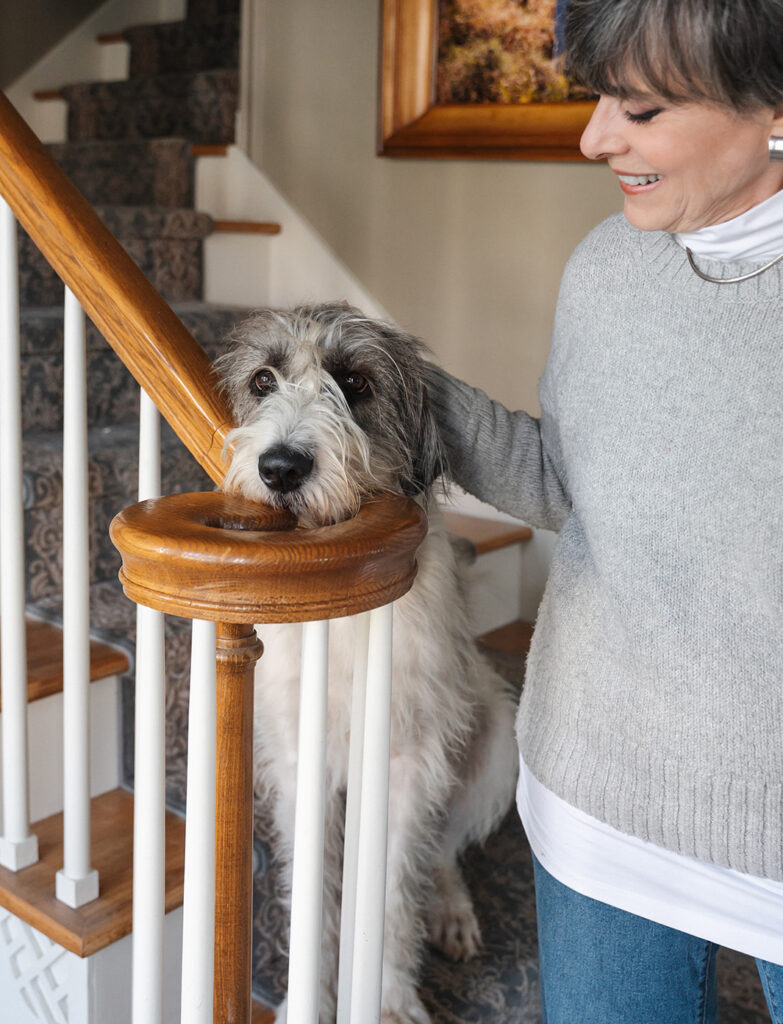
Layla is still a work-in-progress when greeting guests, but we stay consistent with our rule of calmly greeting guests.
2. Floors, Zoomies, and Puddles
Flooring is one of the first areas to show signs of pet wear. Opt for materials that resist scratches and are easy to clean. Hard-surfaced floors are best for keeping dust bunnies at bay and for cleaning puddles of any kind.
- High-quality laminate and luxury vinyl plank (LVP) are affordable, water-resistant, and scratch-resistant, which makes them great pet-proof choices.
- Tile or sealed concrete offers a sleek and very durable option that won’t trap odors. Heated tile creates winter comfort, while no heat creates refreshing, cool summer comfort.
- Hardwood can add stunning pet-friendly charm. Select harder species such as oak or hickory with a matte finish to hide scratches. Another hardwood perk is that it reduces paw traction, which helps slow the speed of those spontaneous zoomies, saving wear and tear on the house. Zoomies are vital for our pets’ wellbeing, so when they start, try to get them into a fenced yard so they can work off their need-for-speed.
3. Area Rugs Reign over Carpet
Avoid wall-to-wall carpet; it harbors pet dander, bacteria, fleas, body fluids, body odors, lanolin from pet fur, etc. Keep in mind that the amount of pet grime that accumulates on a hard-surfaced floor will be the same amount accumulated in the pile of wall-to-wall carpet. Another issue is that toenails and claws can snag the carpet and even unravel the yarns, which can be an expensive repair.
Instead of wall-to-wall carpet, use area rugs. They not only add style and warmth to your home, but they can also be lifted for cleaning underneath. This is very useful when cleaning puddles that soak through the pile. Not only can the rug be lifted to allow cleaning, but it can also allow lingering odors to air out. If you have a puppy in training, consider storing expensive or heirloom area rugs until potty training is understood.
For pet-friendly area rugs, look for rugs that are:
- machine-washable or indoor-outdoor quality, making them easy to maintain.
- similar in color to the color of your pet’s fur to help disguise clinging loose pet hair.
- patterned or darker-toned color to help disguise dropped pet hair and mask minor stains.
- Use rug pads to help hold them in place, especially in high-traffic areas. A rug pad also extends the life of the area rug while adding an extra layer of soft warmth underfoot.
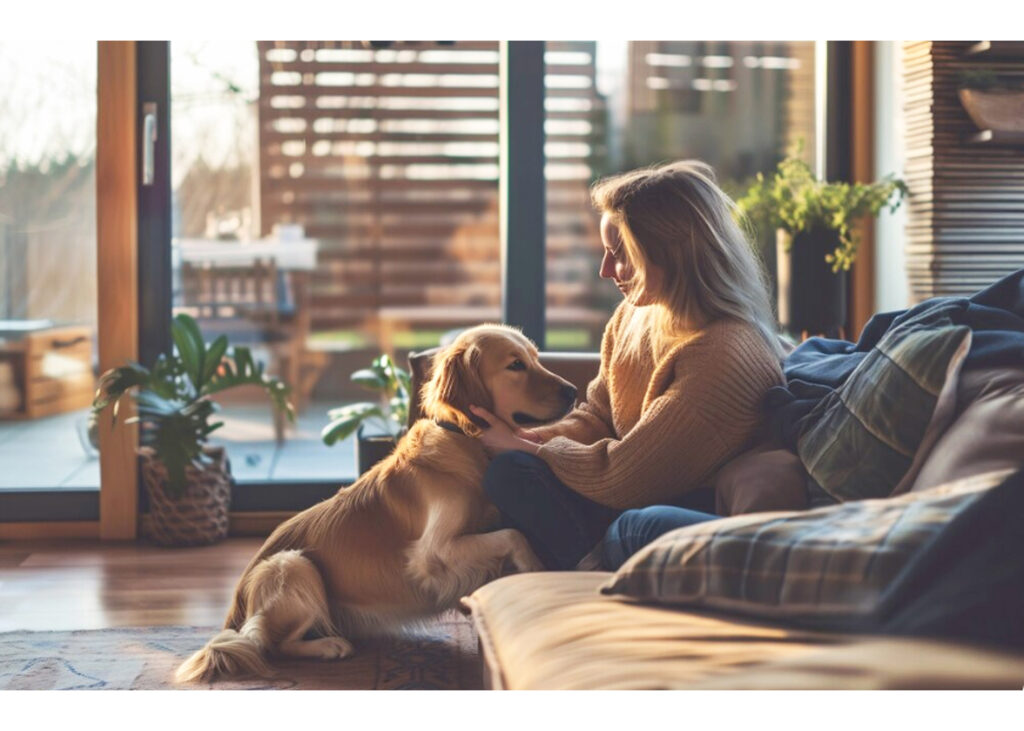
4. Protect your Furniture Investment
Furniture is an investment and should be respected by humans and animals. If your house rules allow pets on the furniture, then select furniture wisely. Stylish durability should be a top priority; look for solid construction and tightly woven upholstery or leather. A sofa takes a lot of wear, especially with pets around. Choosing well-built furniture that can withstand being jumped on and dug into is definitely using wisdom. Also, select fabrics that can withstand claws, fur, and the occasional accident:
- Look for commercial-quality furniture. Many manufacturers offer a commercial quality that looks soft and inviting. When an item is labeled as “commercial,” it has been designed and tested to withstand excessive use.
- Select performance fabrics like Crypton, microfiber, leather, or indoor/outdoor fabrics such as Sunbrella. These fabrics will make cleaning muddy paw prints, happy slobbers, and sifting fur a snap. For cat owners, look for scratch-resistant fabrics.
- Avoid velvet, silk, boucle, and loop-textured fabrics. These can attract pet hair and are more difficult to clean. Also, textured fabrics can be easily snagged and can even damage a pet’s claws.
- Select quality slipcovers or throws. High-quality slipcovers are a great option for washing and seasonal updates. Take the time to select the appropriate slipcover that fits your furniture nicely; it should tastefully coordinate with your décor yet provide the durability for exuberant cuddling.
5. Integrate Dedicated Pet Spaces
Dogs are clan-oriented; they want to be with their human family, and I would not want it any other way. In our house, Layla is not allowed on our furniture; instead, she has her own “furniture”. She learned which furniture (beds) were hers and which were ours on the first day she arrived. She loves her cozy spaces sprinkled around the house in the areas that we use the most. This lets her be a part of our everyday life while giving her space to freely roll around, or lay half-on and half-off, or curl up as she wishes. It’s natural for pets to claim their territory; it gives them a safe place to relax, carry their treasures, and escape.
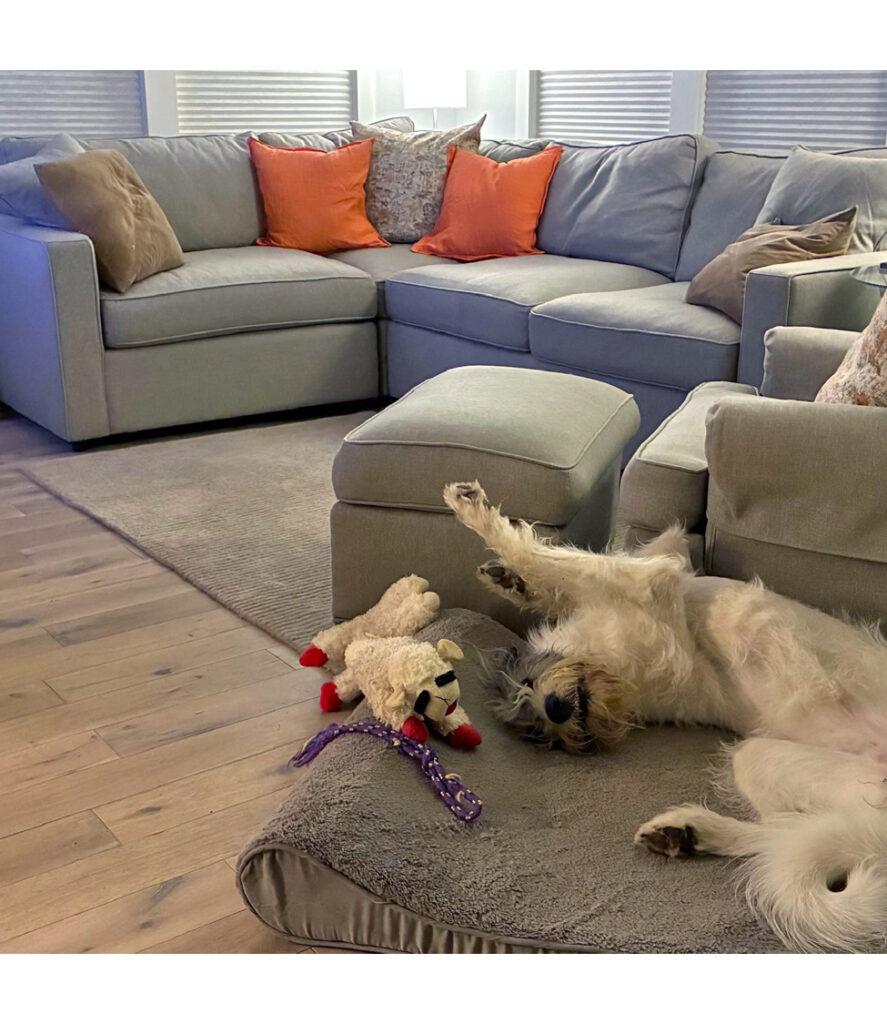
Here are some ideas to help you include your pet in your family’s routines:
- Select a stylish bed that complements your décor. There are many bed options to choose from these days, ranging from rustic to sleek. Determine where the bed will be placed. This should not be an afterthought; it should be considered another piece of furniture. Select an appropriately sized bed for the space, as well as your pet’s physique. If you have a small dog, their bed could be tucked below an end table or on the lower shelf of a bookcase. If you have a cat, keep in mind that they enjoy watching the family from on high. Give your pet a space that they naturally will want to gravitate to. Be tasteful and creative when integrating your pet’s needs, and your home can be beautiful and playful.
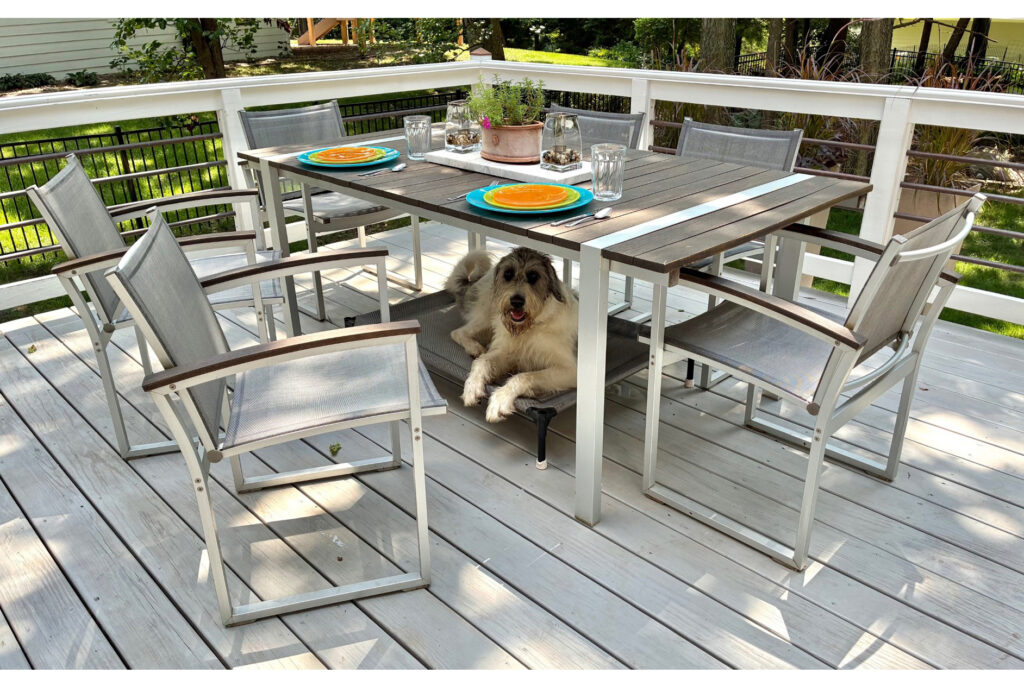
Whether we’re inside or out, Layla has her space to be included in the fun.
- Set up a feeding station that they can own. Layla has a feeding station built into the kitchen island. Since she is large, it needed to be elevated, so designing a shelf that matched the kitchen’s design worked perfectly. The shelf is removable, providing flexibility to add another stool to the island. Take a fresh look at your kitchen, mudroom, laundry room, or back entry. Find an easily-accessed, safe area that is out of the traffic flow to carve out a peaceful pet dining space. Use easy-to-clean mats, stylish feeding dishes, and attractive food storage to create a charming, functional oasis.
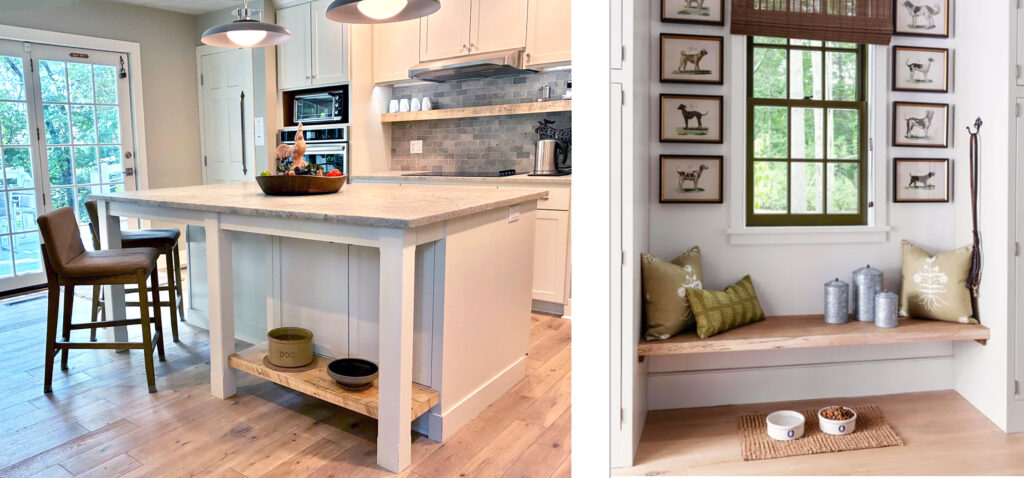
Both elevated feeding stations for large pets and ground-level stations for small pets can add stylish function to your home. (right photo: Southern Living / mudroom ideas)
6. Be Smart with Décor and Accessories
Pets are curious; they learn by touching, playing, smelling, and tasting e-v-e-r-y-t-h-i-n-g! And don’t forget, those happy tails (and paws!) can be destructive. Since we don’t want to squelch their education, it’s best to guard things of value:
- Keep fragile items out of reach or in enclosed cabinets.
- Use plant stands or hanging planters for pet-safe greenery. If you have a plant-grazer in your family, research the plants you want to bring home before you bring them home. (Click here for a basic A-Z toxic plant summary), but it may be easier to just research the specific plants you are interested in.
- Secure furniture to prevent tipping if pets jump or bump into it. The real goal should be teaching your pet not to jump on furniture (or humans), but while they are in training, things should be stabilized.
- Block off areas with baby gates or doors. If you are concerned about your pet chewing the wires beneath your desk, or digging in the laundry basket, or making a scratching post out of the toilet paper, then simply block the areas of your home or close the doors to the “off-limits” rooms. This not only keeps your pet safe, but it also keeps your home and décor beautiful.
7. Ventilation and Smell Control
Even the cutest pets can cause unwanted odors. Here are a few design tricks that help manage them:
- Use air-purifying plants like spider plants or birds nest ferns. (Click here for more pet-safe plants)
- Include pet-safe candles or diffusers to keep your home smelling fresh. Only use unscented beeswax candles and/or diffusers with pet-safe 100% pure organic essential oils. I personally only recommend Young Living Oils, but there are other quality companies. Not all essential oils are created equal. Please research the company or contact me to learn more about using essential oils around your scent-sensitive pets.
- Wash pet beds, blankets, and toys regularly. Consider placing them near windows or in sunny spots to keep them aired out, even moving them to the deck or patio for several hours can be beneficial. If your pets play outside, they are bringing whatever they got into back inside the house. I think it is safe to say that they get dirtier than we do. Since it’s typical to wash our bedding weekly, I recommend doing the same with the pet’s bedding. Also, dogs and cats have lanoline oil in their fur, which soaks into their bed covers, causing lingering odors.
- An air-purifier can significantly reduce odors and the levels of pet dander and hair—along with other aggravating allergens and pollutants. Look for HEPA (high-efficiency particulate air) filters; they are certified to remove particles as small as 0.3 microns. When these filters are properly maintained, they should remove minuscule matter such as: pet dander, mold, bacteria, chemicals from toxic cleaning products, and dust.
- Use only non-toxic cleaning products. I strive for a non-toxic home on all levels, which includes keeping cleaning clean! A home can be refreshingly cleaned with these simple items: vinegar, water, lemon, baking soda, and Bon Ami. I also use Young Living’s “Thieves Household Cleaner”, a naturally non-toxic all-purpose cleaner that disinfects while it cleans. That is my arsenal. Plain and simple. A dog’s sense of smell is over 100 times more sensitive than ours; a bloodhound can be 300 times more sensitive. Chemical-based cleaning products can cause illnesses, hormone imbalances, respiratory issues, kidney malfunctions, mental imbalances, etc. By keeping your cleaning products clean, your home can be sparkling, healthy, and refreshingly uplifting. (Contact me for easy cleaning recipes.)
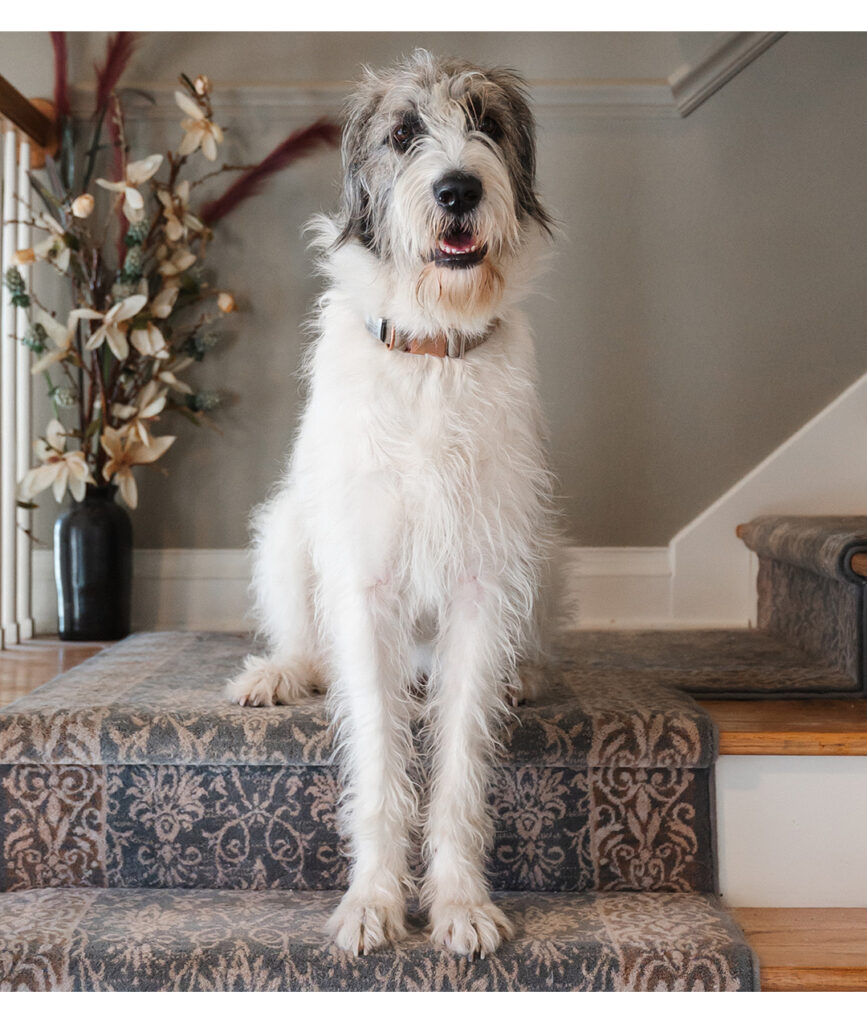
Final Thoughts
Designing a pet-friendly home doesn’t mean sacrificing style. With a few smart choices, you can create a welcoming space for both you and your four-legged companion. From choosing the right fabrics to integrating your pet’s needs into your decor, the perfect balance between chic and functional is absolutely achievable.

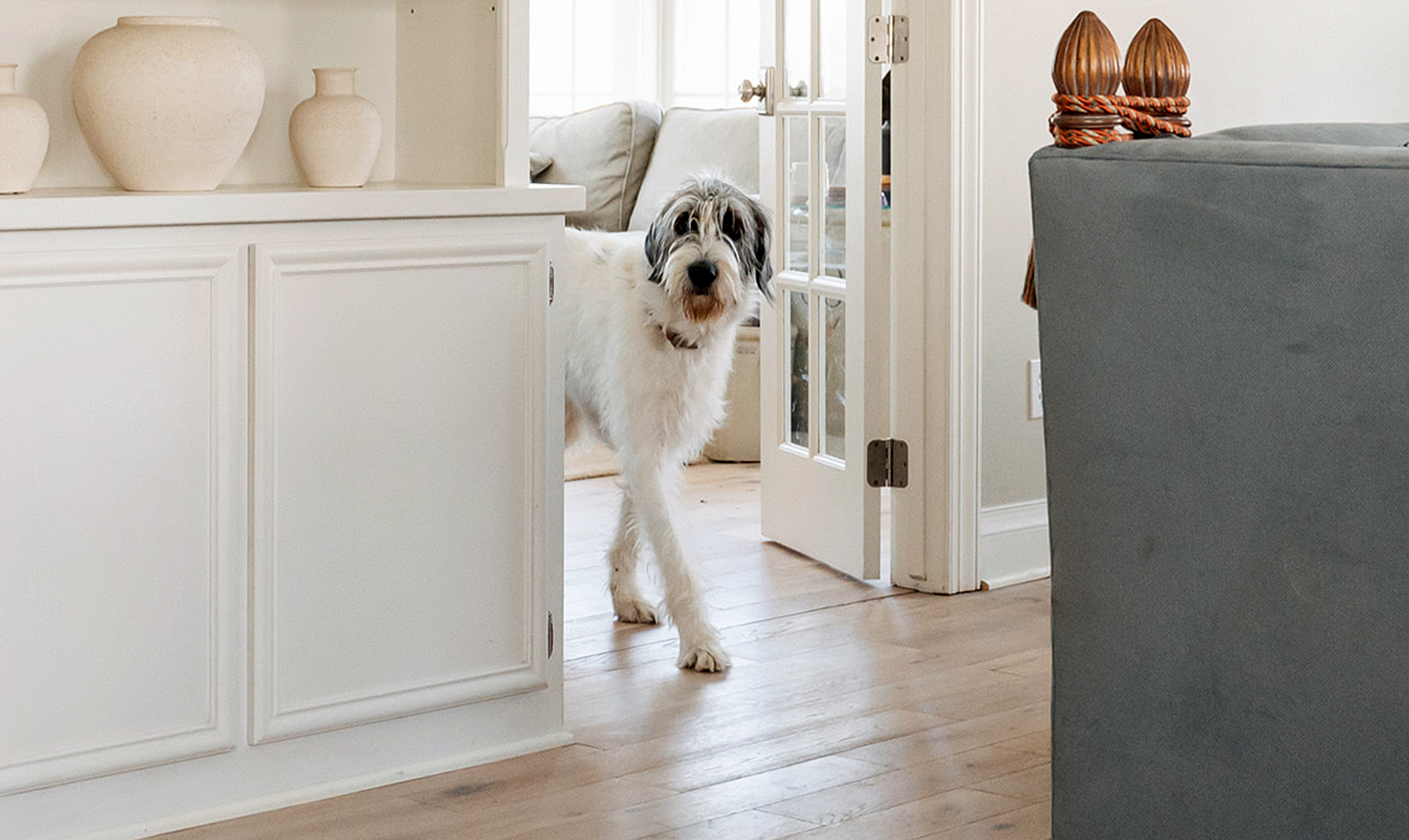
Leave A Comment